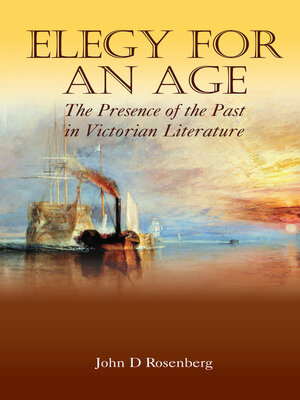Elegy for an Age
ebook ∣ The Presence of the Past in Victorian Literature · Anthem Nineteenth-Century
By John D. Rosenberg

Sign up to save your library
With an OverDrive account, you can save your favorite libraries for at-a-glance information about availability. Find out more about OverDrive accounts.
Find this title in Libby, the library reading app by OverDrive.



Search for a digital library with this title
Title found at these libraries:
| Library Name | Distance |
|---|---|
| Loading... |
This rich and elegant work describes how the unsettled cultural climate provided fertile soil for the flourishing of elegy. John Rosenberg shows how the phenomenon of elegy pervaded the writing of the period, tracing it through the voices of individuals from Carlyle, Tennyson, Darwin and Ruskin, to Swinburne, Pater, Dickens and Hopkins. Finally, he turns from particular elegists to a common experience that touched them all - the displacement of the older idea of the earthly city as a New Jerusalem by the rise of a new image of the Victorian city as an industrial Inferno, a wasteland of sprawling towns and of rivers so polluted they caught on fire.
|In an age of radical transformation, the Victorians were caught between a vanishing past and an uncertain future. In the face of such a dizzying present, connecting with their past became for the Victorians a kind of survival strategy - this nostalgia took forms as diverse as their obsession with history and origins; the religious revivalism of the Oxford Movement; and the new Houses of Parliament, built in 1834, whose design looked longingly back to the Middle Ages.
This rich and elegant work describes how the unsettled cultural climate provided fertile soil for the flourishing of elegy. John Rosenberg shows how the phenomenon of elegy pervaded the writing of the period, tracing it through the voices of individuals from Carlyle, Tennyson, Darwin and Ruskin, to Swinburne, Pater, Dickens and Hopkins. Finally, he turns from particular elegists to a common experience that touched them all - the displacement of the older idea of the earthly city as a New Jerusalem by the rise of a new image of the Victorian city as an industrial Inferno, a wasteland of sprawling towns and of rivers so polluted they caught on fire. This beautifully written meditation provides a vivid, compelling and authoritative portrait of an era that, in the face of an exhilarating and menacing present, longingly embraced the stability and comfort of a past both real and imagined.







